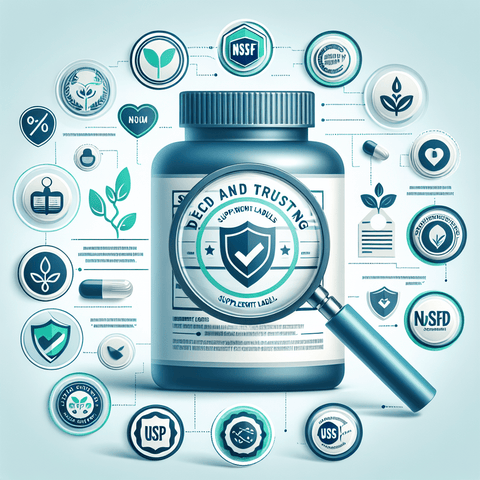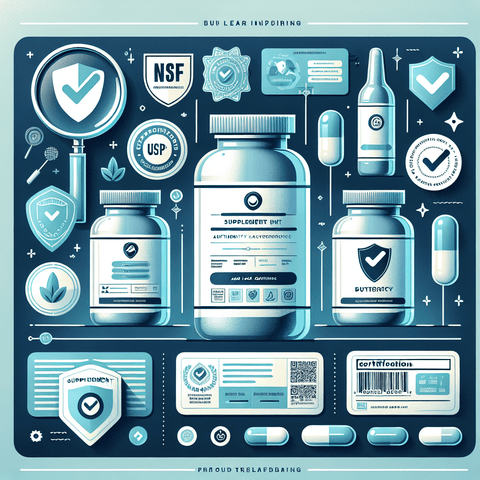In an era where health-conscious choices are becoming mainstream, dietary supplements have emerged as essential tools for supporting overall wellness, managing deficiencies, and enhancing specific health aspects. However, alongside this surge in supplement use comes a critical challenge: understanding what the labels really mean. Misleading claims, confusing ingredient lists, and a lack of transparency can make it difficult for consumers to make fully informed decisions. This comprehensive guide aims to "unlock the truth about supplement labels," empowering you to distinguish reputable products from questionable ones and to select supplements that truly benefit your health. Whether you're a seasoned supplement user or just beginning your health journey, understanding label details is vital for ensuring both safety and efficacy.
Navigating Supplement Labels: Your First Step to Smarter Supplement Choices
Supplement labels serve as the primary source of information for consumers, providing crucial details about what’s inside the product, recommended dosages, health claims, and manufacturing standards. Typically, a supplement label includes the product name, serving size, ingredient list, nutritional information, suggested use, warnings, and manufacturer details. These components, when properly understood, can guide consumers toward safer, more effective choices.
Accurate labeling isn't just about transparency; it directly impacts safety. For example, if a product claims to contain a certain herbal extract but the label reveals minimal quantities or undisclosed fillers, its true efficacy is questionable. Conversely, labels that provide clear serving sizes, ingredient sources, and third-party testing information offer peace of mind, suggesting a product that adheres to stricter quality standards.
Unfortunately, mislabeling remains a pervasive issue, often fueled by lax regulations and profit-driven motives. Unregulated claims such as “miracle cure” or exaggerated health benefits are red flags, and consumers need to approach such claims critically. Misinformation or insufficient regulation can lead to unsafe consumption, allergenic reactions, or simply wasted money on ineffective products. Therefore, understanding how to read labels effectively is the critical first step in becoming a savvy supplement consumer.
To maximize safety and efficacy, always look for products that are transparent about their ingredients and manufacturing practices. Educating yourself on common label elements and recognizing deceptive marketing tactics will help you avoid falling prey to false claims and substandard products. In essence, mastering your reading of supplement labels is the foundation upon which informed health decisions are built.
Dietary Supplement Transparency: Why It Matters and How to Find It
Transparency in the dietary supplement industry entails full disclosure of product contents, sourcing, manufacturing practices, and third-party testing outcomes. When a supplement company embraces transparency, it fosters trust and gives consumers the confidence that they are choosing products aligned with rigorous quality standards. This openness not only helps consumers verify what they are ingesting but also plays a significant role in preventing contamination, adulteration, or undisclosed allergens.
One of the most significant indicators of transparency is third-party testing, which involves independent organizations verifying the product’s ingredient list and potency claims. Certifications from companies such as NSF International, ConsumerLab, or USP provide assurances that the supplement meets specific purity and potency standards. Additionally, clear disclosures about ingredient sourcing—whether from organic farms, sustainable suppliers, or ethically farmed botanical sources—demonstrate a company's commitment to honesty and quality.
Practical tips for consumers include scrutinizing labels for certification logos, researching manufacturer reputations, and reviewing the company's transparency policies on their websites. Brands that openly share detailed information about their ingredient sourcing, testing procedures, and quality assurance processes are generally more reliable. Furthermore, avoiding products with vague labels like “proprietary blend” or “custom formula” without ingredient breakdowns can prevent unintentional consumption of potentially harmful or unnecessary additives.
In essence, consumer vigilance, combined with awareness of credible certifications and manufacturers’ transparency practices, enables you to select supplements that are both safe and effective. Achieving transparency is a collective effort: choosing reputable brands encourages industry-wide accountability and pushes other companies to enhance their openness and consumer protection measures.
Supplement Label Decoding: A Simple Guide to Reading and Understanding
Deciphering supplement labels involves understanding the specific language, format, and terminologies used. Most labels begin with the product name and a serving size, which provide the foundation for interpreting the rest of the information. The next critical component is the ingredient list, typically ordered by weight from highest to lowest. Recognize botanical names, as many herbs and plants are listed under Latin names to ensure clarity for herbal ingredients.
Within the ingredient list, you'll often encounter proprietary blends—mixtures that are not detailed openly, making it difficult to assess individual component amounts. Be cautious with these, especially if the claimed benefits seem exaggerated or if the dosage provided appears insufficient for efficacy. The Nutrition Facts panel, if present, outlines the amounts of key nutrients or active compounds per serving, aiding in comparisons between products.
Understanding marketing language is equally important. Terms like “supports immunity” or “boosts energy” are health claims that sometimes lack scientific backing or regulatory approval. Recognize common tactics such as using vague words like “natural,” “pure,” or “holistic” to imply superiority without substantial evidence. Always cross-reference these claims with reputable sources or scientific studies, and look for third-party verification.
Tools such as consumer guides, online databases, and official regulatory websites can be invaluable for cross-checking label claims. For example, apps that scan barcodes or websites that evaluate supplement safety provide additional layers of verification. By practicing label decoding regularly, you develop an intuitive understanding of what constitutes a trustworthy supplement, ensuring your health choices are well-informed.
Supplement Ingredients Revealed: Knowing What You Are Really Consuming
Ingredients are the core of any supplement; they determine efficacy, safety, and your overall experience. Knowing exactly what ingredients are included—and in what quantities—is vital for making informed health decisions. Active ingredients, fillers, binders, preservatives, and additives all play a role in how a supplement performs and how your body reacts.
Active ingredients are the substances responsible for the supposed health benefits—for example, vitamin D in a supplement designed to support bone health or omega-3 fatty acids for cardiovascular benefits. Recognizing these helps you verify whether a product aligns with your health goals, such as choosing a supplement rich in magnesium to support energy metabolism (magnesium supplements).
It’s equally important to identify any fillers, binders, or excipients, which can be problematic for individuals with allergies or sensitivities. For example, some fillers like gluten or artificial dyes can trigger reactions, making ingredient transparency or allergen disclosure essential. Additionally, examining the labeling for known contaminants or banned substances ensures safety, particularly if you undergo drug testing or have specific health conditions.
The quantities of ingredients—often listed as milligrams, micrograms, or International Units—are crucial. Adequate dosage ensures that the supplement can produce the intended benefit; too little may be ineffective, while excessive amounts could pose health risks. For instance, potent herbal extracts like echinacea or turmeric should specify extract percentages or standardized active components (like curcumin content) to inform proper dosing.
Choosing supplements with transparent ingredient lists and clear potency information aligns with a responsible approach to health, giving you confidence that you're consuming what you believe you are. The right supplement, backed by transparent labeling, can become a reliable part of your wellness routine.
Honest Supplement Labeling: The Path Toward Consumer Trust and Better Health
Truthfulness and full disclosure are the foundation of honest labeling practices. When supplement manufacturers prioritize transparency, they build trust with consumers and contribute to safer health outcomes. Honest labeling involves clearly listing all ingredients, quantities, sourcing information, and any potential allergens or contaminants, leaving no room for ambiguity or deception.
Examples of honest label practices include detailed ingredient disclosures, accurate health claims supported by evidence, and certifications verifying purity and quality. Conversely, misleading practices—such as hiding ingredients under proprietary blends or making unsubstantiated health claims—undermine consumer trust and may even pose health risks.
Honest labeling is essential for preventing label fraud and ensuring that products meet quality standards. It also empowers consumers to verify claims independently and make choices aligned with their health goals. Advocating for transparency, asking questions about ingredient sourcing, and choosing brands committed to honesty create market pressure for higher industry standards.
Being an informed consumer involves recognizing honest labels and supporting companies that value integrity. This collective vigilance pushes the supplement industry toward greater accountability, ensuring that health benefits are genuine and products are safe. Your stake in this process can influence industry practices and promote a more transparent marketplace.
Supplement Label Regulations: Understanding the Legal Framework for Supplement Claims
The regulation of dietary supplement labels varies worldwide, but in the United States, the FDA’s scope under the Dietary Supplement Health and Education Act (DSHEA) provides a specific legal framework. Unlike pharmaceuticals, dietary supplements are not required to prove health claims before marketing; instead, they must be truthful and not misleading, with claims supported by adequate evidence.
Under DSHEA, supplement manufacturers are responsible for ensuring product safety and label accuracy, but the FDA’s enforcement often lags behind marketing claims. Labels can include structure/function claims like “supports immune health,” but these must be accompanied by disclaimers if unapproved by EFSA or regulatory entities. The FDA does not pre-approve labels, which leaves room for deceptive claims or mislabeled products.
Common loopholes include the use of ambiguous language, unsubstantiated health claims, or the omission of ingredient details. While third-party organizations and certifications aim to fill this gap, not all products undergo such scrutiny. As a consumer, understanding these regulatory nuances helps interpret labels critically and avoid misleading products.
Awareness of regulation impacts your ability to identify trustworthy products. Supporting brands that adhere to recommended standards and seek third-party verification enhances your safety and promotes better industry practices. Staying informed about evolving regulations and industry standards also ensures your health choices remain current and secure.
Practical Tips for Ensuring Safe and Effective Supplement Use Based on Label Analysis
Combining label analysis with other safety measures enhances your ability to select effective, safe supplements. Cross-referencing label information with reputable sources can uncover discrepancies or hidden risks. For example, verifying active ingredient quantities against scientific literature ensures you’re not over or under-dosing.
Recognize red flags on labels such as vague ingredient lists, exaggerated claims, lack of certification logos, or proprietary formulas that hide ingredient specifics. These signs suggest the need for caution or further research before purchase. Consulting with healthcare providers or nutrition experts can also clarify doubts and help tailor supplement choices to your specific needs.
To inquire further, contact manufacturers directly for questions about sourcing, testing, or ingredient details. Many brands offer customer service channels to clarify label information, fostering transparency and community trust. Staying updated on industry standards and regulations also helps you recognize reputable brands as they emerge or improve their practices.
Regularly reviewing your supplement regimen, understanding the labels, and staying informed can optimize your health benefits while minimizing risks. A vigilant approach to supplement use ensures that your health investments are safe, effective, and aligned with your wellness goals.
Conclusion
In conclusion, understanding supplement labels comprehensively is an essential skill for every health-conscious consumer. The myriad of product options available demands a keen eye for transparency, accurate ingredient disclosure, regulatory compliance, and honest marketing. By decoding labels, recognizing red flags, and supporting transparent brands, you not only protect your health but also contribute to higher industry standards. Knowledge is power, and the more you learn about what goes into your supplements, the better equipped you are to make choices that truly support your wellbeing.
Empowerment begins with awareness—so take charge of your supplement decisions today. A well-informed consumer is an advocate for safety, quality, and honest practices. Remember, your health is your most valuable asset, and understanding labels is your first line of defense in safeguarding it.
Call to Action
Visit topvitamine.com for trusted supplement guides and resources. Share your experiences or questions about supplement labeling to contribute to a more informed community. Stay updated on the latest regulations, product innovations, and industry standards to ensure your supplement choices consistently support your health journey.
Q&A Section
Q1: Why is it important to understand supplement labels?
A1: Understanding supplement labels helps you verify ingredient quality, dosage, and safety claims, preventing you from purchasing ineffective or potentially harmful products. It enables you to make informed choices aligned with your health goals and avoid misleading marketing tactics.
Q2: What should I look for to identify reputable supplement brands?
A2: Reputable brands often display third-party certification logos, disclose sourcing and testing practices, provide transparent ingredient lists, and avoid vague claims or proprietary blends that hide ingredient details. Doing research and reading reviews also helps assess brand credibility.
Q3: How can I decode a supplement label effectively?
A3: Focus on key components such as serving size, ingredient list with botanical names, potency and dosage details, and any certifications. Be cautious of proprietary blends and exaggerated claims. Use reputable resources or apps for additional verification when necessary.
Q4: Why is ingredient transparency critical for supplement safety?
A4: Ingredient transparency ensures you are aware of all components, including active substances, fillers, and potential allergens. It helps prevent exposure to harmful contaminants or allergens and supports proper dosing for efficacy.
Q5: How do regulations impact supplement label accuracy?
A5: Regulations, such as the FDA’s DSHEA, set standards for truthful labeling, but enforcement can be inconsistent. While labels should be truthful and not misleading, some products still make unsubstantiated claims. Consumers need to be vigilant and seek third-party verification.
Important Keywords
- supplement labels
- regulatory standards
- ingredient transparency
- third-party testing
- label decoding
- safe supplementation
- health claims regulation
- product sourcing
- consumer protection
- quality assurance



